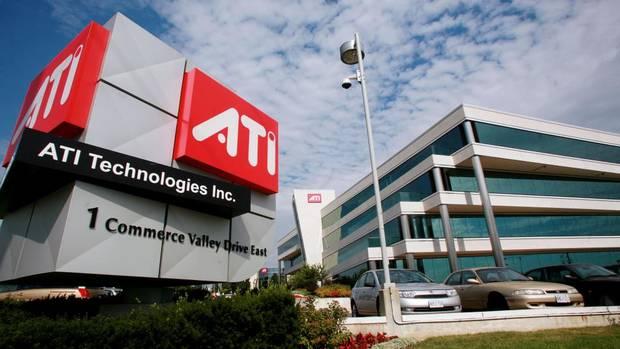 ATi Technologies
ATi Technologies
Advanced Technology Information Systems (ATI) was one of the largest manufacturers of graphics expansion cards for the IBM PC and its compatibles. The company, who started under the name of Array Technology, Inc., was founded in 1985 by Lee Ka Lau, Francis Lau, Benny Lau, and Kwok Yuen Ho from China, and were based in Markham, Ontario.
Graphics Card Product Lines (click the link to jump to a dedicated page for that card):
| Wonder series (1987-1992) | Mach series (1991-1996) | Rage series (1996-2000) | Radeon series (2000-) |
|---|---|---|---|
| EGA Wonder (1987) EGA Wonder 800 (1987) EGA Wonder VIP (1987) EGA Wonder 800+ (1988) Small Wonder v1 (1988) Small Wonder v2 (1988) VGA Wonder (1988) VGA Wonder 16 (1988) Prism VGA/Prism Elite (1989) VGA Wonder+ (1990) VGA Integra (1990) VGA Basic 16 (1990) VGA Wonder 1024D (1990) VGA Charger (1991) VGA Wonder XL (1991) VGA Wonder XL24 (1992) Stereo F/X series (1992/1993) |
Graphics Ultra (1991) Graphics Ultra Plus (1992) Graphics Vantage (1992) Graphics Ultra Pro (1992) WinCharger (1994) |
3D Rage (1996) 3D Xpression (1996) 3D Rage II (1996) 3D Rage IIc AGP (1996) 3D Xpression+ (1996) All-In-Wonder (1997) 3D Rage II+ DVD (1997) 3D Charger (1997) 3D Rage Pro (1997) Video Xpression+ (1998) 3D Rage Pro Turbo (1998) 3D Rage XL/XC (1999) Rage 128 Pro (1999) Rage 128 Ultra (1999) Rage 128GL/Rage Fury (1999) |
Radeon 7000-series (2000) Radeon 8000-series (2001) ... |
Wonder Series (1987 - 1992)
The Wonder series was ATi's entry into the PC graphics card market, initially offering cards that were a good alternative to IBM's standard ones which were very expensive. In most cases, ATI offered better functionality and higher performance with these cards, and at a much more attractive price point. The first EGA cards in the range used ATI's new 16899 chipset paired with a Chips & Technologies graphics processor.
The Small Wonder cards all used an early new chip of ATI's called 18700. They were the only cards to use this chip.
The EGA Wonder 800+ was the first to use the new 18800 chip in 1989 alongside the new VGA Wonder. The 18800 was capable of some VGA resolutions, despite being put onto "EGA"-branded cards. This was followed by the 18820 and 18830, used by some of the VGA Wonder 16 series. Up to this point these were all considered 1st-generation chips, with the key limitation being its 512 KB maximum video memory.
In 1990, the 2nd generation of graphics chipsets arrived in the form of the 28800, all capable of accessing up to 1 MB of video memory. Cards that got this 2nd-gen chip include the VGA Wonder+, VGA Integra, VGA Basic-16, VGA Wonder 1024D, VGA Charger, VGA Wonder XL and VGA Wonder XL24. This was fairly shortlived, however, with the Mach 8 arriving just one year later.
Mach 8 Series (1991 - 1992)
The mach8 chip (38800) was ATi's 3rd-generation chip, and was their first graphics accelerator. It was effectively a clone of IBM's 8514/A XGA chip found on some of their high-end PS/2 computer series, though they implemented it on the ISA bus rather the Micro-Channel Architecture (MCA). Launched in 1991, mach8 was used on the Graphics Ultra and Graphics Vantage cards.
Mach 32 Series (1992 - 1995)
The mach32 chip (68800) is the immediate predecessor to the mach64 family. The mach32 was register compatible with both the IBM 8514/A and the mach8. The mach32 also contained a VGA controller on the chip that was compatible with the VGA Wonder so a separate VGA controller was not needed. The memory on the mach32 board was shared between the VGA controller and the mach32 accelerator. The mach32 improved upon the mach8 by providing a linear aperture to allow fast image data transfer by mapping the video memory to the system memory address space. Later revisions of the mach32 also were able to memory map the mach32 registers to overcome the performance penalty incurred in going through I/O port-mapped registers. Finally, the mach32 contained a hardware cursor. mach32-based boards were produced in five bus types: ISA, EISA, VESA Local Bus, Microchannel, and PCI.
Mach 64 Series (1995 - 1996)
The mach64 represented a departure from the mach32 in that it was no longer register
compatible with previous ATI graphics accelerators or the 8514/A. (VGA register
compatibility was retained, however.) This departure was necessary to resolve some
design limitations that were a legacy of the older generation chips. Fortunately, almost all
the functionality that was in the mach32 was preserved in the mach64 design, and some
useful additions and enhancements were incorporated.
As indicated on the table below, the mach64 can be divided into two major types, the GX
family and the CT family. While applications that use the mach64 should run on both
types with little or no modification, there are some important differences between the two families that are highlighted in the following sections.
Boards based on mach64 are produced in ISA, VESA Local Bus and PCI bus versions.
The mach64 family was further split into mach64GX, mach64CT, and mach64VT:
Mach 64GX
The mach64GX family encompasses the mach64GX (ATI888GX00) and mach64CX (ATI888CX00) variants. The major distinguishing characteristics of this family are the use of an external DAC and external clock synthesizer, support for VRAM, the VGA controller is VGA Wonder-compatible and is independently programmable from the accelerator controller. From a very rough architectural perspective, the mach64GX family more resembles the mach32 than it does the mach64CT family. However, from a functionality and register level perspective, the mach64GX is almost identical to the mach64CT.
Mach 64CT
The mach64CT family encompasses the mach64CT (ATI264CT), mach64VT (ATI264VT) and mach64GT (3D RAGE) variants. The major distinguishing characteristics of this family are integrated DAC and clock synthesizer, no VRAM support, the VGA controller is 'pure' VGA (not VGA Wonder-compatible) and the VGA controller is not independently programmable from the accelerator controller.
Mach 64VT
The mach64VT family of chips is built upon the previously mentioned CT. They have the same feature set as the CT, plus some additional video features such as a back-end hardware overlay and back-end hardware scaler.
RAGE Series (1996 - 1999)
Mach 64GT (3D RAGE, RAGE ii, ii+, IIc, RAGE PRO)
The mach64GT (commonly known as the 3D RAGE) introduced hardware support for 3D operations. The 3D RAGE included all mach64VT features with the addition of hardware 3D acceleration, improved video filtering, and integrated motion compensation (RAGE PRO only). In order of performance for gaming desktops, the Rage series looks like this, from slowest to fastest:
- 3D Rage, 1996 (1996)
- Rage II+ DVD (1997)
- Rage Pro (1997)
- Rage IIc (1996)
- Rage Pro Turbo (1998)
- Rage 128 Ultra (1999)
- Rage 128 Pro (1999)
- Rage Fury (1998)
- Rage Fury MAXX (2000)
Mach 64LB (RAGE LT-PRO)
The mach64LB (commonly known as the RAGE LT-PRO) provides the mach64GT core hardware support for 3D operations. The RAGE LT-PRO includes all mach64GT features with the addition of an integrated TV-Encoder, LVDS, and Dual CRT Controllers, plus the graphics subsystem power.
Mach 64GM (RAGE XL)
The mach64GM (commonly known as the RAGE XL) provides the mach64GT core hardware support for 3D operations. The RAGE XL includes all mach64GT features with the addition of an integrated TMDS for flat panels and integrated motion compensation.
Mach 64LM (RAGE MOBILITY M/P/M1)
The mach64LM (commonly known as the RAGE MOBILITY) provides the mach64GT core hardware support for 3D operations. The RAGE MOBILITY includes all mach64GT features with the addition of very low graphics subsystem power, integrated TMDS for flat panels and hardware DVD decode via integrated iDCT.
2000 and Beyond
In 2000, ATI acquired ArtX, which engineered the Flipper graphics chip used in the Nintendo GameCube game console. They also created a modified version of the chip (codenamed 'Hollywood') for the successor of the GameCube, the Wii.
ATI Technologies was acquired by AMD in July 2006 for $5.4 billion, where its operations became part of the AMD Graphics Product Group (GPG), who continued with the Radeon line. On 30 August 2010, AMD announced that they would retire the ATI brand for its graphics chipsets in favor of the AMD name.

